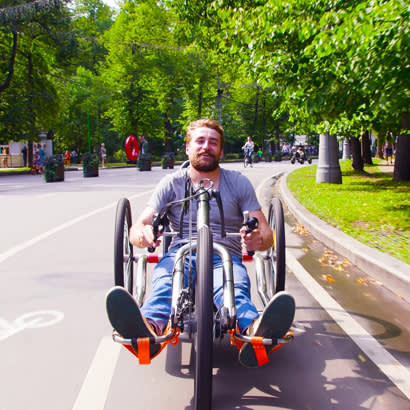
Pictured: A person with a disability enjoys riding an accessible bike in the park.
This blog post is part one of a series about facilitating inclusion for people with disabilities in parks and recreation. Today we will explore the meaning of inclusion and why it matters in parks and recreation.
Think back to one of your favorite memories of taking part in a recreational activity. Maybe it was a simple picnic in the park with your family, playing pickleball or kayaking down a canal. Consider what made it so special to you and your family. All too often, individuals with disabilities and their family members have encountered disappointing experiences trying to participate in parks and recreation in their communities.
When we think about inclusion in parks and recreation, the goal is to make positive experiences and memories accessible and available to everyone. This blog post will explore why inclusion in parks and recreation matters and four ways to facilitate inclusion in parks and recreation.
What is Inclusion?
First, let’s define inclusion. A friend and former colleague of mine, Anita O’Brien from Rochester Accessible Adventures, said it this way: “Inclusion is doing what you want to do, when you want to do it, and with the people you want to do it with.” This definition highlights the importance of personal choice when it comes to inclusion. In the words of Verna Myers, “Diversity is being invited to the party, inclusion is being asked to dance.” This metaphor highlights the importance of belonging. Inclusion allows individuals to experience belonging and creates opportunities for agency or choice. In park and recreation settings, this provides benefits not only to the individual with a disability, but also to their family, the organization and the community.
Disability is a natural part of the human experience and a critical component of diversity. Up to one in four adults in the United States live with some form of disability — 27 percent of all adults (CDC). People with disabilities experience several barriers, largely due to those created by a society of majority able-bodied individuals. The social model of disability (Figure 1) tells us that many of the difficulties encountered by individuals with disabilities come from the social environment, not the disability itself. The image of an individual in a wheelchair at the bottom of a staircase captures this idea well. It is not the wheelchair or the individual that is the problem, but the built environment — the staircase.

Pictured: Person with a disability on an electric wheelchair is stopped at the bottom of an inaccessible staircase, as he is unable to reach the top.
Figure 1:

Barriers like the ones shown in the image above (e.g., inaccessible environments, attitudes, organizational policies) create environments that are not accessible nor inclusive for people with disabilities, but we can change this. Park and recreation organizations can provide support to create equitable environments and programming that facilitate inclusion. In the next blog post in this series, we will cover how to facilitate inclusion at an organizational level.
After reading this blog post, take a minute to think about how disability plays a role in your own life. Consider family, friends and loved ones who either have a disability or are impacted by disability in their lives. Consider how they may want to be included in parks and recreation in their own communities and the barriers that may prevent them from doing so.
Stay tuned for part two of the series, “How to Facilitate Inclusion at an Organizational Level,” coming next month.
Portions of this content reflect an inclusion curriculum developed at the University of Rochester Strong Center for Developmental Disabilities.
To learn more about how you can support inclusion in parks and recreation, visit NRPA’s Parks for Inclusion resource page.
Jennifer Ward (she/her) is an evaluation manager at NRPA.

